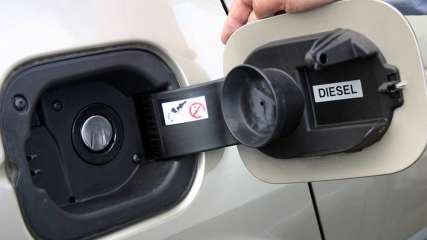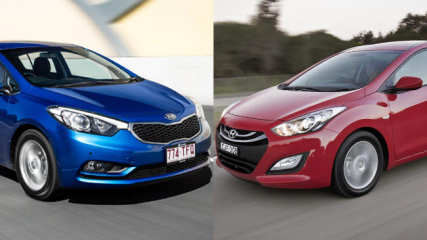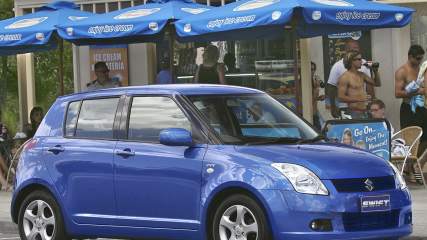Kia Sportage Advice
.jpg)
Unmarked police cars Australia: How to spot an undercover cop car
Read the article
By Stephen Corby · 05 May 2025
There are some states where the very existence of unmarked police cars seems almost as illogical as it is cruel, while in others, like Victoria, it’s a surprise that every second vehicle isn’t a cop car in disguise.
.jpg)
What Are The Most Fuel Efficient Cars in Australia
Read the article
By Tom White · 17 Feb 2025
The most economical car argument is still a valid one, despite the fact that oil prices have stabilised around the world.
.jpg)
What's the average width of a car?
Read the article
By Marcus Craft · 19 Apr 2023
What is the average width of a car?The average width of a car is 1.94 metres.That figure comes from averaging the width of popular vehicle types spanning the Australian new car market.The average width of a small/compact SUV is about 1800mm, the average width of a medium SUV is about 1840mm, the average width of a large SUV is about 1860mm, the average width of an upper large SUV is about 1980mm, the average width of a ute is about 1870mm, and the average width of a US pick-up is about 2300mm.One of the most crucial factors you must take into account when buying a car is whether it will fit in the allocated place in which you plan to park it when it’s not being used – whether that be a resident-only car park, your driveway, garage, car port, etc. And, of course, a vehicle’s width is part of this.So, how wide are cars? Whether you’re buying a hatchback, a sedan, a wagon or a full-size US pick-up, you must know the dimensions of your potential purchase in order to ensure you’re able to safely house it at your home.Car widths differ depending on the vehicle type, for instance a Hyundai i30 (1795mm) is not anywhere near as wide as a Ram 1500 pick-up (2465mm).Note: for the purposes of this yarn, we’re focussing on commercially available mainstream passenger vehicles.So, what is the average width of a car? As the old saying goes: how long’s a piece of string?Read on.The width of different vehicle models within the same realm – hatchbacks, sedans, wagons, SUVs, utes, pick-ups, etc – does not vary as greatly as length may. By its very nature, a motor car has to accommodate at least two seated people across its width.How much do vehicles differ? Not a whole lot, really. Models that occupy the same section of the market will be within 150mm of each other in terms of width.A small urban car, perhaps well suited to a couple or a couple and their labradoodle, will need less people- and cargo-space than a gargantuan, bush-based, horse-trailer-towing US pick-up that regularly carries five people (and two dogs in the tub).So, it’s logical the city runabout vehicle will take up less physical space – and so offer less room – than something like an outback load-lugger.But generally speaking, cars within the same realm – hatchbacks, sedans, wagons, SUVs, utes, pick-ups – will have similar measurements.And remember, a carmaker’s listed vehicle specifications will often include two width measurements: without the wing mirrors extended (which we will use throughout this yarn), and with the wing mirrors extended.Of course there is, and which one you prefer – wider or narrower – mostly boils down to your lifestyle and specific vehicular needs.The main advantage of having a narrow(er) car (hatchback, etc) is its ease of parking in urban areas. For your reference, the minimum dimensions of a small car parking space in Australia (as per the Australian Standard AS 2890) is listed as 2.3 metres wide by 5.0m long. So, there’s that…The main advantage of having a wider car (wagon, van, ute) is the fact that its extra width translates into more interior room and cargo space, meaning (hopefully) more comfort and greater people- and/or cargo-carrying ability.How much do car widths differ by within the same category? Well, I reckon there’s about a maximum 150mm difference between the narrowest and widest in each vehicle type. Reckon I’m incorrect? Good for you. Feel free to push back in the comments section.In Australia we use the metric system of measurement. In this feature, we’ll refer to a car width in millimetres, which is a standard specification measurement in the vehicular world, rather than listing a car width in metres or an average car width in cm or, god forbid, feet.The Federal Chamber of Automotive Industries (FCAI) defines selected vehicle types on their footprint (defined as length - mm x width - mm, rounded).This is a more considered way of calculating how much space a vehicle occupies, rather than merely thinking about only its width or length.First up, micro, light or small cars* – we’re talking about vehicles such as Kia Picanto, Suzuki Ignis, Toyota Yaris, Hyundai Kona and the like.(* Micro: “Hatch, sedan or wagon with a footprint < 6300mm”; Light: “Hatch, sedan or wagon with a footprint range 6301-7500mm”; or Small: “Hatch, sedan or wagon with a footprint range 7501-8300mm”, according to the FCAI.)The narrow Picanto is listed as “from 1595mm” across, according to our dimension experts here at carsguide.com.au. The wide-for-a-small-car VW Polo is listed as having a width “from 1751mm”, by the CG mob.CarsGuide has listed the Subaru Impreza width as “from 1775mm” wide, and the Ford Focus is listed as “from 1825mm" wide.The average width of a small SUV (with a length - mm x width - mm less than 8100mm) in this part of the vehicular market, according to CarsGuide measurement experts, falls somewhere between 1760mm wide (Kia Stonic) and 1819mm wide (Volkswagen T-Roc).Let’s jump to medium SUVs – (with a FCAI-defined footprint of 8101mm-8800mm) – which includes vehicles such as Kia Sportage, Mazda CX-5, Mitsubishi Outlander, Toyota RAV4, Nissan X-Trail, Volkswagen Tiguan, etc. These vehicles are referred to as “medium” or “mid-size” and may have five or seven seats.The average width of a medium SUV falls somewhere between 1800mm (Mitsubishi Outlander, as listed by CarsGuide) and 1883mm wide (Ford Escape, as listed by CarsGuide).Large SUVs can carry up to seven people; upper large SUVs are able to carry up to eight passengers.The average width of a large SUV (with an FCAI-listed footprint of between 8801mm and 9800mm) such as Toyota Prado, Land Rover Discovery and their ilk, falls somewhere between 1815mm (Mitsubishi Pajero Sport, as noted by CarsGuide) and 2008mm (Land Rover Defender, as noted by CarsGuide).Upper large SUVs have a FCAI-defined footprint bigger than 9801mm. Think 300 Series LandCruiser (“from 1970mm wide”), Hyundai Palisade (“from 1975mm wide”), and Nissan Patrol (“from 1995mm” wide).Utes are classified as light trucks, which are “vehicles designed principally for commercial but may include designs intended for non-commercial applications."They’re available as two-wheel drive (4x2) or four-wheel drive (4x4) vehicles, and as a cab chassis or with a tub at the rear.These vehicles can legally carry up to five people in the cabin, depending on the body type, and have a FCAI-defined footprint of between 9001mm and 9501mm.The average width of a ute available in Australia falls somewhere between 1815mm (Mitsubishi Triton, as listed by CarsGuide) and 1954mm (VW Amarok, as listed by CarsGuide).Pick-ups are like utes on steroids and the availability of these US 'trucks' is no longer restricted to Australia's grey imports market.Pick-ups – we’re talking about the likes of the Ram 1500, the Ram 2500, the Chevrolet Silverado, the Ford F-150, etc – are now available via mainstream distributors. The average width of these vehicles falls somewhere between 2063mm wide (Chevrolet Silverado, as listed by CarsGuide) and 2630mm wide (Ram 3500, as listed by CarsGuide).If you’re reading this yarn on the CarsGuide website – and not on some dodgy website that’s pilfered our content and is pretending it’s their own – then look up at the menu bar at the top of the page and tap ‘Pricing and Specs’. That will take you, yes, to the ‘Pricing and Specs’ section. Also, feel free to visit the appropriate car-maker’s website and download any specification sheets that are relevant to your particular choice of vehicle. Make sure you look at the correct make-model-variant details.
.jpg)
What's the average length of a car?
Read the article
By Marcus Craft · 12 Apr 2023
When you’re buying a car there are numerous factors to take into account but perhaps the most important question you have to ask yourself before buying your new or second-hand vehicle is: how long is it?
.jpg)
Five best small SUVs for towing
Read the article
By David Morley · 02 Nov 2021
It’s generally agreed that, when it comes to towing, the bigger, heavier the car doing that job, the better.

Should I buy a diesel or petrol car?
Read the article
By Stephen Corby · 05 Jul 2020
There’s long been a bit of a stench around diesel, but with the Volkswagen scandal and big cities in Europe now considering banning them, it seems to be a fuel source that’s more on the nose than ever
.jpg)
Best good-looking car buys by segment
Read the article
By Craig Duff · 05 Jul 2020
We spend weeks comparing new car performance and prices... then fall for a shiny one.

Best of Kia and Hyundai cars
Read the article
By Paul Gover · 11 Feb 2019
Once you dismiss the differences in the bodywork and the individual tuning of the suspension, it’s obvious they come from the same rootstock.It’s the same with the Kia Sportage and Hyundai ix35, and just about everything else in the two brands’ showrooms. Kia has its Soul and Grand Carnival, and Hyundai has the Veloster and coming Genesis luxury sedan but the mainstream stuff is identical.That’s no surprise. The companies are part of the same giant South Korean industrial complex, which manufactures everything up to supertankers. Hyundai and Kia began separately and the latter is actually the older company, with a history running back to 1944. When it ran into trouble in the Asian economic meltdown it was brought into the Hyundai family with a bailout package that has also included shared development and basic model plans.In Australia, Hyundai and Kia are take-no-prisoners rivals but in some countries they are bundled together. In Canada, Hyundai-Kia rates second on the sales charts and is only trumped by Chrysler. If you did the same thing in Australia, the South Korean combination would also rate second overall. Hyundai was fourth in the 2013 rankings behind Toyota, Holden and Mazda with sales of 97,006 vehicles.When you tip in the extras from Kia, the number jumps to 126,874, a total eclipsed only by the 214,630 of Toyota. Combine i30 and Cerato tallies, to 36,367, and they’re still in fourth - but they move the total further ahead of Commodore and only 3000 short of the third-placed Toyota HiLux.But don’t expect anyone at either Kia or Hyundai in Australia - the red and the blue teams, as they are known, because of their corporate colours - to push for any sort of alliance. “The two companies are set up to compete,” says Kia spokesman Kevin Hepworth.Part of that competition led Kia to push strongly for a local “personality” in its cars, something provided by engineering and suspension guru Graeme Gambold. It’s no surprise that Hyundai is now doing something similar, with a different feel.Hyundai and Kia are not alone on the South Korean front. Daewoo cars conveniently fly Holden badges and Ssangyong the country third, behind Japan and Thailand. That places Thailand as a photocopy country producing runs of cars designed somewhere else - think the excellent Ford Ranger from Australia.On the other hand, South Korea pushes hard for class and quality and now builds better Japanese cars than Japan, in terms of value, quality and reliability. Kia is also creating a reputation for great design and Hyundai is aiming for the big breakthrough, a worthy luxury car, with the Genesis that lands here later in the year.Both are also driving great value for Australian car buyers. So it’s probably a good thing for customers - and their rivals - that the red and blue teams regard themselves as deadly rivals and not just one brand with two showrooms.Kia SportagePrice: from $25,490Rating: 3.5/5Engine: 2.0-litre 4-cyl 122kW/197Nm, 2.0-litre 4-cyl turbo diesel, 135kW/392NmTransmission: 5-speed/6-speed man/auto; FWDThirst: from 7.2L/100kmThe lowdown: One of the first Kia models to benefit from Australian suspension tuning and a Carsguide favourite as a result. It’s been overtaken by the Mazda CX-5 and Subaru Forester but is still roomy, well equipped, excellent value (on the ownership front too) and a good drive.Hyundai i30 Price: from $20,990Rating: 4/5Engine: 1.6-litre 4-cyl, 107kW/175NmTransmission: 6-speed man/auto; FWDThirst: from 6.8L/100km The lowdown: Recent suspension improvements mean the i30 drives even better, although its age means it rates third in class behind the VW Golf and Mazda3. The i30 has become a new-age Corolla, the car you recommend to people who just want trouble-free, cost-effective motoring. It’s better than the Toyota and a winner with its five-year warranty and service package.Hyundai Santa FePrice: from $37,990Rating: 3.5/5Engine: 2.4-litre 4-cyl, 141kW/242Nm, 2.2-litre 4-cyl turbo diesel, 145kW/421NmTransmission: 6-speed man/auto; AWDThirst: from 6.5L/100kmTHE LOWDOWN: The Santa Fe is tough to toss on the value front, with the seven-seater capacity that’s essential for a lot of families. It’s now a generation newer under the skin than its Kia Sorento rival, which means it drives better and is also quieter. It’s a reversal of the Sportage-ix35 match-up, where Carsguide prefers the Kia. Customers are the real winners.SECOND-HANDThe bland but efficient Hyundai Getz has taken over from the Toyota Corolla as the Carsguide choice for first-car buyers. The boxy little baby ticks all the right boxes, from price to economy, and we rarely hear of mechanical problems. They were sold in huge numbers and that means good value as a used car. Hyundai first made its name on the second-hand scene with the jelly bean-shaped Excel, although it was never a great car, and the Getz is building from that base. There’s a big advantage for used buyers - the five-year warranty and affordable servicing mean Getz new-car buyers have been more likely to give their cars the care and attention that pays off for subsequent owners.This reporter is on Twitter: @PaulWardGover

Best used cars for sale under $7000
Read the article
By Graham Smith · 07 Dec 2017
Buying cheap second hand cars is a risky business. Buy the right car and you can look forward to many years of affordable, worry-free motoring, but buy the wrong one and your motoring dream could become an expensive nightmare. In buying a cheap used car you're potentially buying someone else's problems, but there's no

Kia to trade on quality over outright value
Read the article
By Paul Gover · 25 Sep 2015
The days of dollar deals in Kia showrooms are on the way out.





